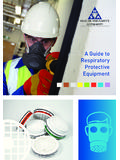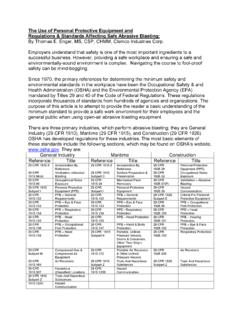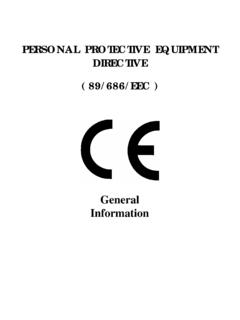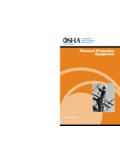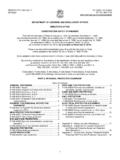Transcription of HealthandSafety WL55 Respiratoryprotective …
1 Health and Safety Executive 5. WL5. COSHH essentials respiratory protective equipment (RPE). for welding, hot work Control approach R. and allied processes respiratory protective equipment (RPE). This information will help Access and premises employers (including the Only allow access to authorised staff. self-employed) comply with the Control of Substances equipment Hazardous to Health Provide RPE. Regulations 2002 (COSHH), as amended, to control exposure and protect workers' Procedures health. Make sure that workers check their RPE works properly every time they put it on. It is also useful for trade union safety representatives.
2 Visually check compressed gas and air lines for signs of damage before use. Welding fume can cause lung disease, with Remove grease and all surface coatings first, unless they are meant to an increased risk of asthma and cancer. be welded or cut through. Cutting fume is associated with an For work outdoors, work upwind of the fume. increased risk of lung disease and asthma. Arrange work so that the worker's head is out of the fume. Check for gas leaks. This sheet describes good practice using RPE. Maintenance, examination and testing It covers the points you need to follow to It is vitally important to maintain RPE in effective and efficient working order.
3 Reduce exposure to an adequate level. Follow the instructions in the manual. It is important to follow all the points, or If any equipment is faulty, stop work until it is repaired. use equally effective measures. Make sure that users examine their RPE and test it works properly before each use. Main points Examine and test RPE thoroughly at least once every three months. Dust and fume can cause serious lung Check the air flow and air quality to air-fed RPE at least once every diseases. three months or before use. Ensure that compressors take in only Keep exposure as low as possible clean air. using all the controls in this sheet.
4 Keep records of all examinations and tests for at least five years. Health monitoring is usually needed. Review records - failure patterns show where preventive maintenance See sheet G401. is needed. See manufacturers' safety data sheets If hot work involves cadmium, seek advice on biological monitoring - - select safer consumables. see Useful links'. Personal protective equipment (PPE). Ask your safety equipment supplier to help you get the right PPE. Provide storage for clean and contaminated PPE. respiratory protective equipment (RPE). RPE is always needed. Welding, hot work and allied processes WL5 respiratory protective equipment (RPE).
5 Provide a powered or air-fed welding helmet that suits the wearer, the job and the work environment. For more heavy duty work, use a compressed air-line helmet to BS EN 270 standard. See sheet R5. For normal work, use a type LDH2 air-line helmet to BS EN 1835. standard or type TH2 powered filtering helmet to BS EN146/EN12942. See sheet R3. For short-term tasks, type P3 high-efficiency disposable RPE is acceptable. Could there be a confined space? If so select air-line RPE. Make sure all RPE is properly fit-tested - get advice from your supplier. Make sure that workers check their RPE works properly before use. Replace RPE filters as recommended by your supplier.
6 Throw away disposable masks after one use. Keep RPE clean and store it away from dust. Other protective equipment Provide and ensure that workers use flame-resistant overalls and protective gloves. Use a properly equipped contract laundry or a suitable equivalent to wash work clothing. Skin creams help in washing contamination from the skin. After-work creams help to replace skin oils. Caution: Never allow use of compressed air for removing dust from clothing. Health monitoring You should consider health monitoring. See sheet G401. Consult an occupational health professional - see Useful links'. Cleaning and housekeeping Keep the work area clean and free of combustible materials.
7 Dispose of hazardous wastes safely. Training and supervision Tell workers that fume from welding and cutting can cause serious lung diseases. Working in the right way and using the controls correctly is important for exposure control. Train and supervise workers. See sheet WL0. Welding, hot work and allied processes WL5 respiratory protective equipment (RPE). Further information Employee checklist respiratory protective equipment at work: A practical guide Do you know how to use HSG53 (Third edition) HSE Books 2005 ISBN 0 7176 2904 X. the controls properly? The safe use of compressed gases in welding, flame cutting and allied processes HSG139 HSE Books 1997 ISBN 0 7176 0680 5 Is your RPE working Health and safety in arc welding HSG204 HSE Books 2000 properly?
8 ISBN 0 7176 1813 7. Check the RPE clean air Hot work on small tanks and drums Leaflet INDG314 HSE Books 2000. supply. (single copy free or priced packs of 10 ISBN 0 7176 1766 1). Safe work in confined spaces Leaflet INDG258 HSE Books 1997 Use, maintain and store (single copy free or priced packs of 20 ISBN 0 7176 1442 5) your protective equipment in For environmental guidelines see sheet WL0 accordance with instructions. Look for signs of leaks, Useful links wear and damage. Your trade association may advise on health and safety consultants and training providers. If you find any problems, For information about health and safety, or to report inconsistencies or tell your supervisor.
9 Don't inaccuracies in this guidance, visit You can view just carry on working. HSE guidance online and order priced publications from the website. Co-operate with health HSE priced publications are also available from bookshops. monitoring. Contact the British Occupational Hygiene Society (BOHS) on 01332. 298101 or at for lists of qualified hygienists who can Wash your hands before help you. eating, drinking, or using the Look in the Yellow Pages under Health and safety consultants' and lavatory. Health authorities and services' for occupational health'. Never clean your hands Also see with solvents or Biological monitoring - contact the Health and Safety Laboratory (HSL).
10 Concentrated cleaning e-mail or other service laboratories. products. Use skin creams provided as instructed. This document is available at: and This document contains notes on good practice which are not compulsory but which you may find helpful in considering what you need to do. Crown copyright If you wish to reuse this information visit for details. First published 04/06. Published by the Health and Safety Executive 08/11.










